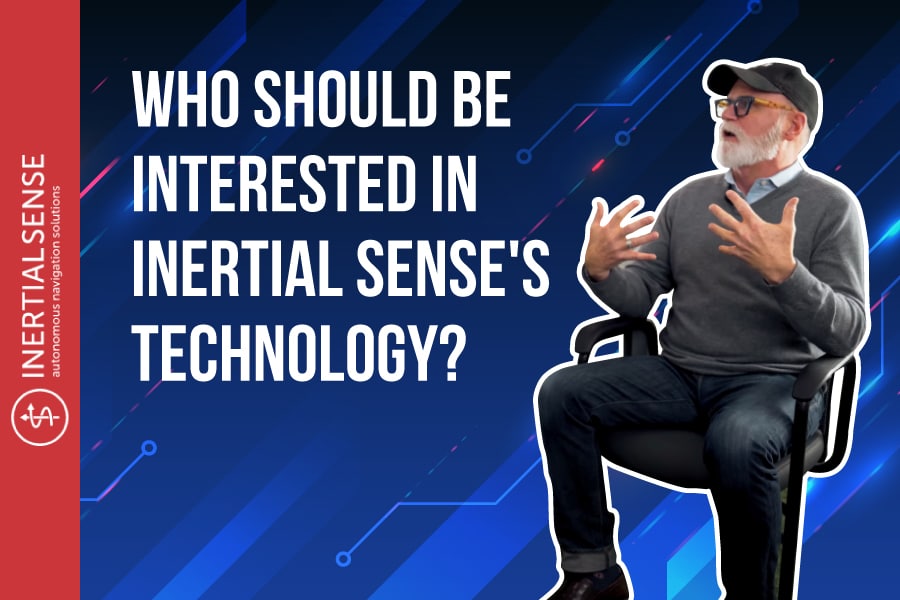
Who Should Be Interested In Inertial Sense’s Technology?
Technology has come a long way, but still has such a long way to go. There are many clients that come to Inertial Sense. Watch this video below as Carson and Brett discuss what kind of clients come to Inertial Sense and why.
Inertial Sense not only serves small startup companies, but we offer tactical grade technology, extending to military applications. With the ability to offer 1.8 to 2 degrees per hour stability, Inertial Sense is always learning and growing right along with technology.
It’s never too late to get your autonomous robotics with the most up-to-date software and firmware. Let Inertial Sense get you started today, and get in touch with one of our knowledgeable experts!
Learn More:
What Does Inertial Sense Have To Offer To Investors? (Part 1)
What Does Inertial Sense Have To Offer To Investors? (Part 2)
Inertial Sense Technology: The Path To Revenue For Autonomous Mobile Robotic Manufacturers
Video Transcript
So with these more accurate sensors and better redundancy in there, what kind of opportunities are we seeing for a different clientele who might be more interested in this kind of precision?
So the type of client that we’re searching for that would use this sensor isn’t going to change. It’s just going to be higher quality, higher quality parts, you know. So right now because we’re an industrial grade, there’s only a certain level we can provide.
We can provide accuracy for until we hit a ceiling. Because we’re now using a tactical grade, those use cases are going significantly higher. Like you hear the words industrial versus tactical. What do you understand by those concepts? Industrial means industrious, business commercial space. Tactical you open up doors into possible military applications in comparable applications as well.
So you talked about the end and run by stability. Did you talk about the specific improvements between the old and now, like it’s going to be this much better?
Yeah, so so the in-run bias stability for the INS 3.2 is 10 degrees. This is gonna be five times the performance. So we will be seeing 1.8 to two degrees per hour and run by a stability meaning you can go five times longer without GPS signal and remain accurate.
So, it’s kind of, it sounds a little bit like iPhone upgrades where you have some better hardware, it allows you to do a little bit more things when you upgrade your hardware incrementally like that.
Exactly. Improved hardware. There’s more hardware in it. The size, the footprint hasn’t changed, you know. It’s still three grams. The only difference is we’ve added an IMU which is a mem, it’s very, very, very small. Wouldn’t even notice it. Everything’s the same, nothing is changing. This module, the 4.0 is going to be backwards compatible with 3.2, so our current client base isn’t going to need to change their footprint or design a new space for a modular fit. It’s going to be a drop-in replacement. It’s going to function with the same hardware. There’s going to be no differences except for the small ones inside the hardware itself.
So one thing you talked about was being able to go without GPS for a while. That’s, can you remind us what that’s called and talk a little bit more about that?
Yeah. So the concept is it’s called dead reckoning, okay. Dead reckoning is being able to navigate when you don’t have GPS or when GPS is not constant, okay. So in our specific applications here at Inertial Sense, we run lawn mowers, okay. What types of interference could we experience onboard a lawn mower when it comes to GPS-denied environments, okay? Like I mentioned earlier, you go under a tree, okay, the branches interfere with that signal and make it difficult for the robot to localize and know exactly where it is. The sensor will be able to compensate for those inaccuracies inside the GPS and basically give you the precision that the GPS would provide without the GPS.
So is it even necessary to have a GPS? Do you, could you just use the sensor without any GPS on it?
Any outdoor application should have a GPS on board just because it’s going to improve the accuracy all-around. You could just put a simple INS on there, but without GPS, you have no knowing exactly where that robot is going, where that robot, or where that machine is going to start, right? So it gives you a starting point, goes underneath the tree, and then at some point it comes out and it corrects everything and you can draw a line that was drawn just by the navigation sensors, and then the GPS will pick it up where the inertial sensors.
So they kind of help each other out.
Sensor fusion.
Alright, it’s called sensor fusion. Perfect, awesome.

